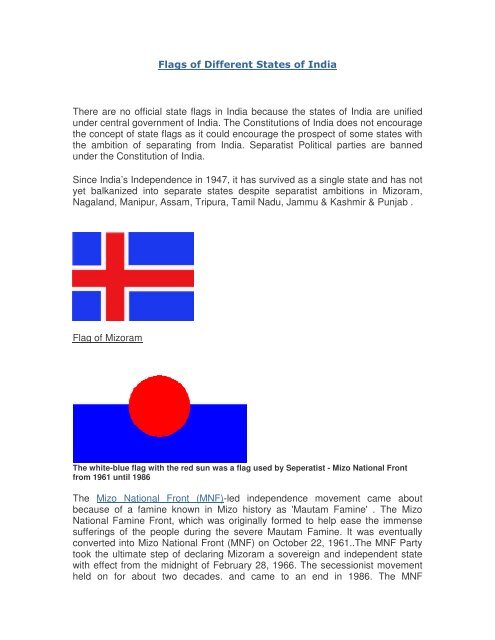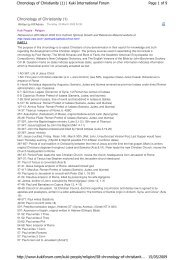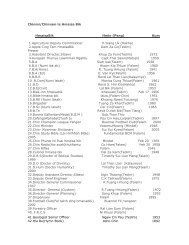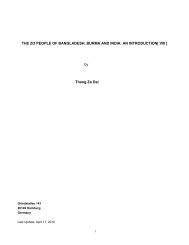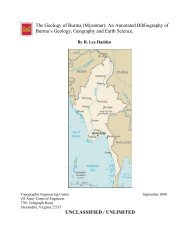Flags of Different States of India - Zomi Online Library
Flags of Different States of India - Zomi Online Library
Flags of Different States of India - Zomi Online Library
You also want an ePaper? Increase the reach of your titles
YUMPU automatically turns print PDFs into web optimized ePapers that Google loves.
<strong>Flags</strong> <strong>of</strong> <strong>Different</strong> <strong>States</strong> <strong>of</strong> <strong>India</strong><br />
There are no <strong>of</strong>ficial state flags in <strong>India</strong> because the states <strong>of</strong> <strong>India</strong> are unified<br />
under central government <strong>of</strong> <strong>India</strong>. The Constitutions <strong>of</strong> <strong>India</strong> does not encourage<br />
the concept <strong>of</strong> state flags as it could encourage the prospect <strong>of</strong> some states with<br />
the ambition <strong>of</strong> separating from <strong>India</strong>. Separatist Political parties are banned<br />
under the Constitution <strong>of</strong> <strong>India</strong>.<br />
Since <strong>India</strong>’s Independence in 1947, it has survived as a single state and has not<br />
yet balkanized into separate states despite separatist ambitions in Mizoram,<br />
Nagaland, Manipur, Assam, Tripura, Tamil Nadu, Jammu & Kashmir & Punjab .<br />
Flag <strong>of</strong> Mizoram<br />
The white-blue flag with the red sun was a flag used by Seperatist - Mizo National Front<br />
from 1961 until 1986<br />
The Mizo National Front (MNF)-led independence movement came about<br />
because <strong>of</strong> a famine known in Mizo history as 'Mautam Famine' . The Mizo<br />
National Famine Front, which was originally formed to help ease the immense<br />
sufferings <strong>of</strong> the people during the severe Mautam Famine. It was eventually<br />
converted into Mizo National Front (MNF) on October 22, 1961..The MNF Party<br />
took the ultimate step <strong>of</strong> declaring Mizoram a sovereign and independent state<br />
with effect from the midnight <strong>of</strong> February 28, 1966. The secessionist movement<br />
held on for about two decades. and came to an end in 1986. The MNF
transformed itself into a regional political party subsequent to the signing <strong>of</strong> a<br />
Memorandum <strong>of</strong> Understanding (MoU) with the government <strong>of</strong> <strong>India</strong> on June 30,<br />
1986.<br />
Flag <strong>of</strong> Tamil Nadu<br />
Before <strong>India</strong>'s independence there was a demand for an independent Dravidian<br />
Nadu (including Tamil Nadu & South <strong>India</strong>) by Periyar EV Ramaswamy for which<br />
the party Dravida Kazhagam was started. But after <strong>India</strong>’s independence, this<br />
demand was watered down for autonomous Dravidian states within the <strong>India</strong>n<br />
union. Articles on Tamil Independence movement in Tamil Tribune.<br />
Flag <strong>of</strong> Manipur<br />
In 1949, the King Budhachandra was invited to, the capital <strong>of</strong> the <strong>India</strong>n province<br />
<strong>of</strong> Assam, where, after an intense negotiations, he was forced to sign an<br />
agreement for annexation <strong>of</strong> the kingdom into <strong>India</strong>. It became a full-fledged<br />
State more than two decades later, in 1972. This delay in granting statehood<br />
caused discontent among the Meiteis who felt that their identification with ‘Hindu<br />
<strong>India</strong>’ brought them no political or economic benefits. This gave rise to<br />
secessionist tendencies among a section <strong>of</strong> the Meiteis and a number <strong>of</strong><br />
separatist groups emerged thereafter. United National Liberation Front (UNLF) &<br />
People's Liberation Army Manipur are the two main Seperatist group.
Flag <strong>of</strong> Punjab<br />
Flag <strong>of</strong> Khalistan<br />
In Punjab, The <strong>India</strong>n state <strong>of</strong> Punjab was created in 1947, when the Partition <strong>of</strong><br />
<strong>India</strong> split the former Raj province <strong>of</strong> Punjab between <strong>India</strong> and Pakistan. The<br />
mostly Muslim western part <strong>of</strong> the province became Pakistan's Punjab Province;<br />
the mostly Sikh and Hindu eastern part became <strong>India</strong>'s Punjab state.<br />
Sikhs demanded an independent Sikh country to be called Khalistan. largely<br />
instigated by a few sikh leaders who believed sikhs too should get a new state<br />
after splitting <strong>of</strong> <strong>India</strong> and Pakistan based more upon religious lines.<br />
Flag <strong>of</strong> Assam<br />
In Assam the Movement is spearheaded by the Seperatist Movement ULFA<br />
(United Liberation Front Assam), was established on April 7, 1979, under the<br />
leadership <strong>of</strong> Paresh Barua. While secession from <strong>India</strong> was the declared goal,<br />
the organisation adopted an anti-foreigner plank since this was the popular issue<br />
gripping the masses in Assam. Pushing its objective <strong>of</strong> secession to the<br />
background, the ULFA operated within the AASU-AAGSP's agitation.
Flag <strong>of</strong> Nagaland<br />
In Nagaland, the Movement is spearheaded by the Seperatist Movements NSCN<br />
IM and NSCN-K. Nagas were the first to raise the banner <strong>of</strong> revolt against the<br />
<strong>India</strong>n government, on August 14, 1947, under the aegis <strong>of</strong> the Naga National<br />
Council (NNC) led by Angami Zapu Phizo.After the death <strong>of</strong> Phizo in 1990, there<br />
was another split in the NNC. NSCN (lM) and NSCN-K are the two main splinter<br />
groups.<br />
Flag <strong>of</strong> Jammu & Kashmir<br />
After the <strong>India</strong>n Rebellion <strong>of</strong> 1857, in which Kashmir sided with the British, the<br />
princely state <strong>of</strong> Kashmir came under the paramountcy <strong>of</strong> the British Crown. Hari<br />
Singh was the reigning monarch at the conclusion <strong>of</strong> British rule <strong>of</strong> the<br />
subcontinent and the subsequent partition <strong>of</strong> the British <strong>India</strong>n Empire into the<br />
newly independent <strong>India</strong> and Pakistan. Both countries agreed that the rulers <strong>of</strong><br />
princely states would be given the right to opt for either Pakistan or <strong>India</strong> or—in<br />
special cases—to remain independent. It was anticipated that the Maharaja<br />
would accede to Pakistan, when the British paramountcy ended. When the<br />
Mahajarj hesitated, Pakistan launched a guerilla onslaught meant to frighten its<br />
ruler into submission. Instead the Maharaja appealed to Mountbatten for<br />
assistance, and the Governor-General agreed on the condition that the ruler<br />
accede to <strong>India</strong>. The Maharaj signed the Instrument <strong>of</strong> Accession. <strong>India</strong> has<br />
control <strong>of</strong> about half the area <strong>of</strong> the former princely state <strong>of</strong> Jammu and Kashmir,<br />
Pakistan controls a third <strong>of</strong> the region, Azad Kashmir. The movement for<br />
Independence is still going on spearheaded by JKLF ( Jammu and Kashmir<br />
Liberation Front) & other separatist organizations.
Flag <strong>of</strong> Tripura<br />
The Ganamukti Parishad movement led to the integration <strong>of</strong> the kingdom with<br />
<strong>India</strong> in 1949. Tripura has been badly affected by the partition <strong>of</strong> <strong>India</strong> and the<br />
majority <strong>of</strong> the population now comprises Bengalis with the Tribal Population<br />
Marginalized. Tripura has two main Seperatist group, the National Liberation<br />
Front <strong>of</strong> Tripura & Tripura Naitonal Volunteers.<br />
The best way to counter this seperatist ambitions seems to be to recognize their<br />
culture, religion and language and not try to homogenize people with a single<br />
language or religion . It must also be pointed out that there must also be all round<br />
development throughout <strong>India</strong> and not only the states who have more population<br />
or Legislators.<br />
Flag <strong>of</strong> Meghalaya<br />
Meghalaya was formed by carving out the two districts <strong>of</strong> the state <strong>of</strong> Assam: the<br />
United Khasi and Jaintia Hills, and the Garo Hills on 21 January 1972.<br />
Meghalaya is a bit different from the other groups in that it does not have any<br />
organizations with separatist ambitions within the state but because it has 2 basic<br />
language speaking people with different cultures within a single state with<br />
lopsided development, the two major tribes - Khasi Jaintia and Garo's are fighting<br />
for a seperate state within the <strong>India</strong>n Union. The Khasi Organizations demanding<br />
a seperate state are Hynniewtrep National Liberation Council (HNLC) and for the<br />
Garo's Achik National Volunteer Council (ANVC), Liberation <strong>of</strong> Achik Elite Force<br />
(LAEF) & People’s Liberation Front <strong>of</strong> Meghalaya (PLF-M). The Garo's are more<br />
backward than Khasi's as the Capital City and most <strong>of</strong> the commercial activity<br />
takes places in Khasi Hills- Shillong.
<strong>States</strong> which have choosen to Integrate with the <strong>India</strong>n Union:<br />
Flag <strong>of</strong> Sikkim<br />
Darjeeling district and Morang were annexed to <strong>India</strong> in 1835, In 1947, a popular<br />
vote rejected Sikkim's joining the <strong>India</strong>n Union and Prime Minister Jawaharlal<br />
Nehru agreed to a special protectorate status for Sikkim.A referendum was held<br />
in which people (most <strong>of</strong> them nepalese) voted to join the <strong>India</strong>n Union. A few<br />
weeks later on May 16, 1975, Sikkim <strong>of</strong>ficially became the 22nd state <strong>of</strong> the<br />
<strong>India</strong>n Union, and the monarchy was abolished.<br />
Flag <strong>of</strong> Orissa<br />
In 1803, the British under the British East <strong>India</strong> Company occupied Orissa after<br />
the Second Anglo-Maratha War. In 1950, Orissa became a constituent state in<br />
the Union <strong>of</strong> <strong>India</strong>.<br />
Flag <strong>of</strong> the Maratha's (Maharashtra)<br />
The Marathas and the British fought the three Anglo-Maratha wars between 1777<br />
and 1818, culminating in the annexation <strong>of</strong> Peshwa-ruled territory in Maharashtra
in 1819. After <strong>India</strong>'s independence in 1947, the princely states were integrated<br />
into the <strong>India</strong>n Union, and the Deccan <strong>States</strong> including Kolhapur were integrated<br />
into Bombay State. On May 1, 1960, Maharashtra came into existence when<br />
Bombay Presidency State was split into the new linguistic states <strong>of</strong> Maharashtra<br />
and Gujarat.<br />
Flag <strong>of</strong> Andhra Pradesh<br />
Flag <strong>of</strong> Nizam <strong>of</strong> Hyderabad<br />
In Colonial <strong>India</strong>, Coastal Andhra became part <strong>of</strong> the British Madras<br />
Presidency.The Nizam <strong>of</strong> Hyderabad retained control <strong>of</strong> the interior provinces as<br />
the Princely state <strong>of</strong> Hyderabad, acknowledging British rule in return for local<br />
autonomy, but after <strong>India</strong>n Indipendence in 1947, the state <strong>of</strong> Hyderabad was<br />
forced to become part <strong>of</strong> the Republic <strong>of</strong> <strong>India</strong> in Operation Polo in 1948 as<br />
Hyderabad State.On 1 November 1 1956 Andhra State merged with the<br />
Telangana region <strong>of</strong> Hyderabad State to form the state <strong>of</strong> Andhra Pradesh<br />
Flag <strong>of</strong> Uttar Pradesh<br />
Uttar Pradesh is central to <strong>India</strong>n culture and politics and was especially<br />
important in modern <strong>India</strong>n history
Flag <strong>of</strong> Haryana<br />
On 1 November 1966, Haryana was carved out <strong>of</strong> the mostly Hindi-speaking<br />
eastern portion <strong>of</strong> Punjab, while the mostly Punjabi-speaking western portion<br />
remained as current day Punjab.<br />
Flag <strong>of</strong> Himachal Pradesh<br />
On 18 December 1970 the State <strong>of</strong> Himachal Pradesh Act was passed by<br />
Parliament and the new state came into being on 25 January 1971<br />
Flag <strong>of</strong> Rajasthan<br />
Rajasthan had never been united politically until Mughal Emperor Akbar created<br />
a unified province <strong>of</strong> Rajasthan.The Rajput kings concluded treaties with the<br />
British in the early 19th century, accepting British sovereignty in return for local<br />
autonomy and protection from the Marathas.At the time <strong>of</strong> <strong>India</strong>'s Independence<br />
in 1947, Rajasthan consisted <strong>of</strong> 18 Princely <strong>States</strong>, two chieftains and a British<br />
administered province <strong>of</strong> Ajmer-Merwara.
Flag <strong>of</strong> Karnataka<br />
After <strong>India</strong>'s independence, the Maharaja, Jayachamarajendra Wodeyar, allowed<br />
his kingdom's accession to <strong>India</strong>. In 1950, Mysore became an <strong>India</strong>n state <strong>of</strong> the<br />
same name; the former Maharaja served as its Rajpramukh (head <strong>of</strong> state) until<br />
1975. Following the long-standing demand <strong>of</strong> the Ekikarana Movement, Kodagu<br />
and Kannada speaking regions from the adjoining states <strong>of</strong> Madras, Hyderabad<br />
and Bombay were incorporated into the Mysore state, under the <strong>States</strong><br />
Reorganization Act <strong>of</strong> 1956. The thus expanded state was renamed Karnataka,<br />
seventeen years later, in 1973<br />
Flag <strong>of</strong> Madhya Pradesh<br />
In 1956, the states <strong>of</strong> Madhya Bharat, Vindhya Pradesh, and Bhopal were<br />
merged into Madhya Pradesh. Madhya Pradesh is a combination <strong>of</strong> a lot <strong>of</strong><br />
Princely states <strong>of</strong> Central <strong>India</strong>.<br />
Flag <strong>of</strong> Travancore (Kerala)<br />
formerly Princely State <strong>of</strong> <strong>India</strong> under British Rule.<br />
After <strong>India</strong> gained its independence in 1947, Travancore and Cochin were<br />
merged to form Travancore-Cochin on July 1, 1949.Government <strong>of</strong> <strong>India</strong>'s
November 1, 1956 <strong>States</strong> Reorganisation Act inaugurated the state <strong>of</strong> Kerala,<br />
incorporating Malabar district, Travancore-Cochin, Kasagrod.<br />
Flag for Jainism ( Religon followed in Gujurati)<br />
After <strong>India</strong>n independence and the partition <strong>of</strong> <strong>India</strong> in 1947, the new <strong>India</strong>n<br />
government grouped the former princely states <strong>of</strong> Gujarat into three larger unit<br />
Saurashtra, Kathiawar peninsula & Kutch.<br />
Flag <strong>of</strong> Bengal ( Undivided Bengal before Partition)<br />
British troops and their local allies captured Chandernagore in March 1757 and<br />
seriously defeated the Nawab on June 23, 1757 at the Battle <strong>of</strong> Plassey. The<br />
British installed their own Nawab for Bengal and extended their direct control in<br />
the south. The First Partition <strong>of</strong> Bengal happened Under Lord Curzon for<br />
Administrative purposes. As partition <strong>of</strong> British <strong>India</strong> into Hindu and Muslim<br />
dominions approached in 1947, Bengal again split into the state <strong>of</strong> West Bengal<br />
<strong>of</strong> secular <strong>India</strong> and a Muslim region <strong>of</strong> East Bengal under Pakistan. East<br />
Pakistan later rebelled against Pakistani military rule to become independent<br />
Republic <strong>of</strong> Bangladesh while West Bengal remains a part <strong>of</strong> <strong>India</strong>.
Flag <strong>of</strong> Jharkhandh<br />
18 districts were carved out <strong>of</strong> Bihar to form Jharkhand state on 15 November<br />
2000.<br />
Flag <strong>of</strong> Goa (Portuguese Colony)<br />
In 1510, Portuguese defeated the ruling Bijapur kings with the help <strong>of</strong> a local ally,<br />
leading to the establishment <strong>of</strong> a permanent settlement in Goa . The Portuguese<br />
intended it to be a colony. After <strong>India</strong> gained independence from the British in<br />
1947, Portugal refused to accede to <strong>India</strong>'s demand to relinquish their control <strong>of</strong><br />
its enclave. Resolution 1541 by the United Nations General Assembly in 1960<br />
noted that Goa was non-self-governing and favoured self determination. Finally,<br />
on December 12, 1961, the <strong>India</strong>n army with 40,000 troops moved in as part <strong>of</strong><br />
Operation Vijay. Fighting lasted for twenty-six hours before the Portuguese<br />
garrison surrendered. Goa, along with Daman and Diu, was made into a centrally<br />
administered Union Territory <strong>of</strong> <strong>India</strong>. The UN Security Council considered a<br />
resolution condemning the invasion which was vetoed by the Soviet Union. Most<br />
nations later recognised <strong>India</strong>'s action, and Portugal recognised it after the<br />
Carnation Revolution in 1974. On May 30, 1987, the Union Territory was split,<br />
and Goa was elevated as <strong>India</strong>'s twenty-fifth state.<br />
Source: http://miyzone.blogspot.com/search?updated-min=2007-01-<br />
01T00%3A00%3A00%2B05%3A30&updated-max=2008-01-<br />
01T00%3A00%3A00%2B05%3A30&max-results=50


